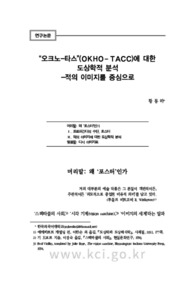

-
미리보기
서지정보
· 발행기관 : 역사학연구소
· 수록지 정보 : 역사연구 / 29호 / 95 ~ 126페이지
· 저자명 : 황동하
초록
This paper examines the verbal and visual elements of a Anti-German Propaganda “Okno-Tass” in Soviet Union during the Great Patriotic War, 1941~1945, from a iconographic point of view. The visual poster is considered as a multimodal text where meaning is created through a complex interaction between verbal and visual components. This article analyses the differentiation on space and the representation structure. The artists locate german soldiers and Hitler etc. on the canvas. The left is the space of death, defeat, the satanic World, and the evil-Hitler himself, while the right is for life, victory, the good-Soviet army. The upper sides is the victorious, good, sacred, ideal space, but the lower sides is the defeat, the evil, and the real space. The variety of presentation-the sentimental and the sardonic, the naturalistic and the expressionist, the obvious and the sophisticated, the laconic and the heroicmanaged to appeal to every taste and relieve the monotony of wartime privations.
The posters themselves are impressive and striking expressions of patriotic fervor and hatred of the enemy. Orchestrated to win over the hearts and minds of the Soviet population and galvanize them in the fight against the invading armies of Fascist Germany, they celebrated the heroism of the Soviet soldiers; used biting satire to pillory the enemy; fostered a hatred of the Germans and encouraged Soviet troops to greater efforts by depicting Nazi atrocities against women and children; responded to military events; and even acknowledged Soviet collaboration with the allies. Hitler and his henchmen are often shown as rather unpleasant animals—rats, snakes, or spiders. The subjects are harrowing and provide a visual history of one of the most terrible wars in history. Clearly, creative aspirations went hand in hand with the passionate commitment to the Soviet cause.영어초록
This paper examines the verbal and visual elements of a Anti-German Propaganda “Okno-Tass” in Soviet Union during the Great Patriotic War, 1941~1945, from a iconographic point of view. The visual poster is considered as a multimodal text where meaning is created through a complex interaction between verbal and visual components. This article analyses the differentiation on space and the representation structure. The artists locate german soldiers and Hitler etc. on the canvas. The left is the space of death, defeat, the satanic World, and the evil-Hitler himself, while the right is for life, victory, the good-Soviet army. The upper sides is the victorious, good, sacred, ideal space, but the lower sides is the defeat, the evil, and the real space. The variety of presentation-the sentimental and the sardonic, the naturalistic and the expressionist, the obvious and the sophisticated, the laconic and the heroicmanaged to appeal to every taste and relieve the monotony of wartime privations.
The posters themselves are impressive and striking expressions of patriotic fervor and hatred of the enemy. Orchestrated to win over the hearts and minds of the Soviet population and galvanize them in the fight against the invading armies of Fascist Germany, they celebrated the heroism of the Soviet soldiers; used biting satire to pillory the enemy; fostered a hatred of the Germans and encouraged Soviet troops to greater efforts by depicting Nazi atrocities against women and children; responded to military events; and even acknowledged Soviet collaboration with the allies. Hitler and his henchmen are often shown as rather unpleasant animals—rats, snakes, or spiders. The subjects are harrowing and provide a visual history of one of the most terrible wars in history. Clearly, creative aspirations went hand in hand with the passionate commitment to the Soviet cause.참고자료
· 없음태그
-
자주묻는질문의 답변을 확인해 주세요

꼭 알아주세요
-
자료의 정보 및 내용의 진실성에 대하여 해피캠퍼스는 보증하지 않으며, 해당 정보 및 게시물 저작권과 기타 법적 책임은 자료 등록자에게 있습니다.
자료 및 게시물 내용의 불법적 이용, 무단 전재∙배포는 금지되어 있습니다.
저작권침해, 명예훼손 등 분쟁 요소 발견 시 고객센터의 저작권침해 신고센터를 이용해 주시기 바랍니다. -
해피캠퍼스는 구매자와 판매자 모두가 만족하는 서비스가 되도록 노력하고 있으며, 아래의 4가지 자료환불 조건을 꼭 확인해주시기 바랍니다.
파일오류 중복자료 저작권 없음 설명과 실제 내용 불일치 파일의 다운로드가 제대로 되지 않거나 파일형식에 맞는 프로그램으로 정상 작동하지 않는 경우 다른 자료와 70% 이상 내용이 일치하는 경우 (중복임을 확인할 수 있는 근거 필요함) 인터넷의 다른 사이트, 연구기관, 학교, 서적 등의 자료를 도용한 경우 자료의 설명과 실제 자료의 내용이 일치하지 않는 경우
“역사연구”의 다른 논문도 확인해 보세요!
-
일제강점기 해수욕장 문화의 시작과 해변 풍경의 변천 28 페이지
Before modern times, an act of sea bathing and a place of sea bathing had a huge significance for healing purposes rather than for leisure or enjoyment regardless of the East and the West. Bathing bea.. -
1930년대 전반기 식민지 조선,이인성의 회화 작품과 미술계의 조선 향토성 - 제국/식민지 체제와 에스닉주의, 그리고 미학(美.. 59 페이지
In the first half of 1930s, Lee Insung(Yi In-sŏng, 1912-1950), Korean Western painter, drew some paintings which expressed the contemporary history under the Japanese Colonial/Imperial regime. One of .. -
이일재의 1940년대 후반기 노동운동, ‘억압된 것의 회귀 노동자평의회’ 사상 34 페이지
Before ‘the August 15 Liberation’ in 1945, Lee Iljae had established a view of the working class movement through reading. He set the ‘anti-Japanese’ goal in the working class. He resisted colonial ru..
문서 초안을 생성해주는 EasyAI

